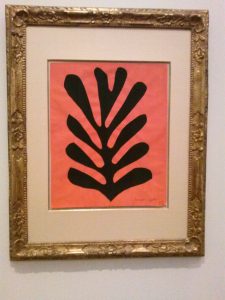Met ‘De oase van Matisse’ heeft het Stedelijk Museum in Amsterdam een prachtige expositie neergezet. Zestig jaar nadat er voor het laatst in Nederland een grote overzichtstentoonstelling van Matisse is geweest, is zijn werk weer in volle glorie te zien. Naast ‘Late Rembrandt’ in het Rijksmuseum is er dus weer een kaskraker in de hoofdstad. De duizenden bezoekers die de Hollandse meester net hebben bewonderd, kunnen rechtsomkeert maken richting Museumplein om zich onder te dompelen in het licht, de lichtheid en de vrolijke zorgeloosheid van de Franse meester.
Henri Matisse (1868-1954) geldt als de meester van het licht, de decoratie, odalisken en arabesken. Zelf kon hij wel eens wakker liggen van hoe deze ogenschijnlijke eenvoud te bereiken. Maar het is hem gelukt. Zie je nu ‘Zwart blad op rode achtergrond’, een ‘knipsel’ uit 1952, dan zie je een blad. Maar dan een plantmotief zoals niemand dat tekende. Toch herken je direct twee dingen: Matisse en een blad. Dat is de wonderlijke en bewonderenswaardige puurheid van Matisse.

Bruiklenen
Het Stedelijk Museum heeft een buitengewoon inspirerende tentoonstelling neergezet. Het museum kon dit doen, juist dankzij het feit dat het jarenlang gesloten is geweest. Toen was het ruimhartig met bruiklenen. En dat betaalt zich nu terug. Musea uit de hele wereld stuurden hun publiekslievelingen naar Amsterdam. Nu zijn hier honderd werken uit de hele wereld te zien, uit Los Angelos, Moskou, Stockholm, Parijs, Nice, Berlijn, Tokio, Kopenhagen, Bazel, Brussel, New York, Philadelphia, Londen. En ook uit Le Cateau-Cambresis, het Noord-Franse dorp waar Matisse 1869 werd geboren.
Combinaties
‘De oase van Matisse’ begint op de begane grond, met de jongste werken en eindigt boven, met de knipsels (‘cut-outs’) uit de laatste jaren van zijn leven. Beneden hangen alle werken van Matisse, uit verschillende periodes, tussen die van andere kunstenaars, uit de eigen collectie. Dat zijn tijdgenoten dan wel kunstenaars die leermeesters voor hem waren. Of juist navolgers die hij heeft geinspireerd. Op de hele tentoonstelling werken de combinaties versterkend. Het zijn ontmoetingen in kleur, licht en tijd. Zelf had je sommige combinaties waarschijnlijk nooit bedacht. Ooit aan Karel Appel naast Matisse gedacht? Terwijl Karel Appel wel degelijk onder de indruk was van de kleursensaties die Matisse teweeg bracht. Appel en Matisse hangen hier hand in hand. En het werkt.

Het levert meer mooie combinaties op. De kleurstellingen passen soms verrassend goed en ook de onderwerpen zijn zo gekozen, dat er wel sprake moet zijn geweest van wederzijdse inspiratie. Dat zie je bijvoorbeeld duidelijk bij Kirchner, die ‘Staand naakt’ uit 1907 op een expositie van Matisse in Berlijn moet hebben gezien. Kirchners doeken en beelden zijn duidelijk verwant aan Matisse. In hun kleurgebruik, hoekigheid en het gebruik van zwarte lijnen passen prachtig naast elkaar. En je ziet hoe Matisse even flirt met het kubisme in zijn ‘Vue de Notre-Dame’ uit 1914 (uit het Moma in New York). Zeker nu het naast Mondriaan wordt gepresenteerd is deze link uiterst krachtig.
Rothko
Een andere eyeopener is de zaal waarin Rothko en Matisse naast elkaar hangen. Volkomen vanzelfsprekend. Rothko was een groot bewonderaar van Matisse. Van hem is bekend dat hij in een bepaalde periode wekenlang naar het MoMa in New York ging om een schilderij van Matisse te bekijken. Dat was niet het schilderij dat nu tussen twee Rothko’s in hangt (De goudvissen, uit 1912), maar je ziet dat het licht en de kleuren werken. Hier hoef je geen hele essays over te schrijven. Gewoon goed kijken en je begrijpt dat het klopt. Dat er in de kunst altijd wisselwerking is geweest, of het nu van tijdgenoten is, of dat voorgangers van invloed zijn geweest. Dat is in alle mogelijke vormen gebeurd.
Verrijkend
Op deze manier heb je de collectie van het Stedelijk nog nooit gezien. Deze opstelling is zowel verrijkend voor Matisse als voor de collectie zelf. Ook de collectie van het Stedelijk belandt zo in een oase van schoonheid, rust, kleur en licht.
En niet alleen dat. Het is gewoon fantastisch om ‘gewoon’ in Amsterdam ‘Femme en bleu’ uit 1937 te kunnen zien. Of ‘Nature morte a la corbeille d’oranges’ uit 1912, dat gewoonlijk in het Musee Picasso in Parijs hangt. De kleuren spatten hiervan af. Interessant ook, om dankzij het boekje ‘Het blauw van de zee en het blauw van de stad’ van Abdelkader Benali, dat bij de expositie verschijnt, te weten te komen dat hij dit in 1912 in Tanger heeft geschilderd. En alleen maar omdat het regende en het buiten grijs en grauw was, zocht hij zijn kleuren binnen in zijn hotel op. In de knalkleuren van de sinaasappels uit Marokko.
Knipsels

Op de tweede etage hangen de knipsels van Matisse, met als middelpunt ‘De parkiet, de zeemeermin’ uit de collectie van het Stedelijk zelf. En daaromheen zie je hoe Matisse zich nog op late leeftijd ontwikkelde met zijn knipsels en op hoge leeftijd nog compleet vernieuwende kunstvorm ontdekte in zijn onderzoek naar licht, vorm en kleur. Dit behoeft geen toelichting. Laat je gewoon onderdompelen in deze weelderige weldaad van vorm en kleur. En stap in de oase van Matisse.
